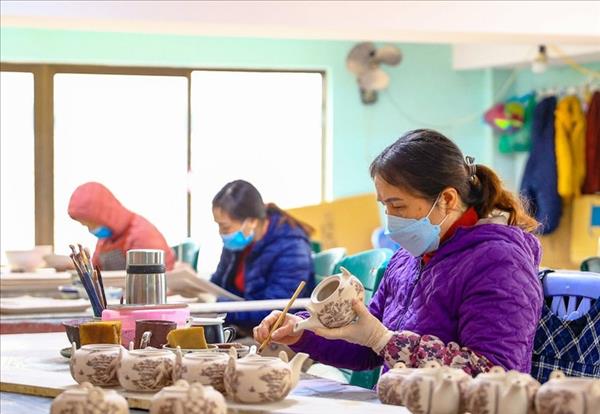Tuong Binh Hiep is one of the oldest lacquer villages in Vietnam, said Tinh, head of Dinh Hoa Lacquerware.
“From 1990 to 2000, the village had more than 2,000 households with about 5,000 lacquerware workers. However, now there are only 1,000. Not many young people want to take up the craft.”
In fact, several large facilities are on the verge of bankruptcy due to a lack of long-term investment. Today, only a few dozen households and establishments are involved in the trade, according to Tinh.
Long history
Lacquer art has a long storied history in Vietnam. The traditional material is often used to decorate furniture, boats, weapons and objects of worship. The products are known for their polished, glossy and luxurious finish.
Because of lacquer's prominence in the country's fine arts, it helps to contribute to tourism industry and socio-economic development. For years, local works have been acclaimed by both international visitors and art critics.
Vietnamese lacquer works are different from those made in other countries like China, Japan and the Republic of Korea, where decorative lacquer is more common. Vietnamese lacquer is more versatile and diverse.
Tran Cong Thien, a lacquerware artisan at Tuong Binh Hiep Village, who has 20 years of experience in the art, says that traditional lacquer is a kind of resin extracted from the sơn tree (Toxicodendrom vernicifluum), which is found in the mountains of the northern province of Phu Tho. The resin is applied in several coats to a wooden base. This is polished to a smooth surface layer which is durable and attractive in look. The lacquer is also painted with pictures, inlaid with eggshells, mother of pearl, gold and other materials, before being processed.
Traditionally, lacquerware colours were mostly black, brown and red. Today, new colours include white, blue, green and yellow to create a modern look. The main materials are wood, bamboo, rattan and, more recently, composite and ceramics.
In each period, lacquer has significantly contributed to the development of Vietnam’s fine arts. In a short period of time, the art form has achieved a high status among Vietnam’s modern arts.
Villagers in Tuong Binh Hiep have preserved their old production process, which involves covering products with 12 to 15 coats of traditional materials, Tinh said.
“A well lacquered product can keep its colour for 400 years,” he said.
According to the book, Binh Duong – A New Power of the 21st Century published by the National Politics Publishers in 2003, migrants from the north, including lacquer craftpersons, travelled along the Sai Gon River and settled in Thu Dau Mot in the early 18th century.
They passed on their traditional craft to locals who have preserved it ever since.
In 1901, the French rulers in Vietnam set up a vocational school in Thu Dau Mot, now the Binh Duong Fine Arts College, to teach carving and lacquerware.
Binh Duong traditional lacquerware became especially popular between 1945 and 1975 with the establishment of Tuong Binh Hiep Lacquerware by artisan Truong Van Thanh, and Thanh Le lacquerware workshop by artisan Nguyen Van Le.
The craft requires meticulous skills. To prevent the paint from drying too quickly, the object has to be kept in a cupboard away from wind and high humidity. Spring and the rainy days of early summer are ideal.
To preserve the craft in the village, younger workers need to be professionally trained, Tinh said.
Money is the key to the craft’s survival, he said, adding that the craft will only survive if the villagers can make a living from it.
“It’s of great importance to promote the business of lacquer art as well as the craftwork so we can expand the market for lacquerware. Another important task for us is to encourage high school students to register for courses in lacquerware or enroll at the Binh Duong Fine Arts College,” he said.
Local authorities need to create favourable conditions for vocational training at the Fine Arts College so that young people could enroll in lacquerware courses, according to Tinh.
Preservation
In recent years, the province has provided assistance in brand building, tourism development, and financial support for production facilities for Tuong Binh Hiep lacquer craft village.
The People's Committee of Thu Dau Mot City has also started a conservation and development project for the craft village that combines tourism in the city and surrounding areas.
The project will include infrastructure investment combined with diverse activities in the tourism industry. It will also create better linkages among production facilities and provide financial support to workshops to invest in new environmentally-friendly machinery.
The Thu Dau Mot People’s Committee said the city will work with local departments and branches in the province to invest in human resource training, trade promotion, and science and technology application.
VNS/VNP

















